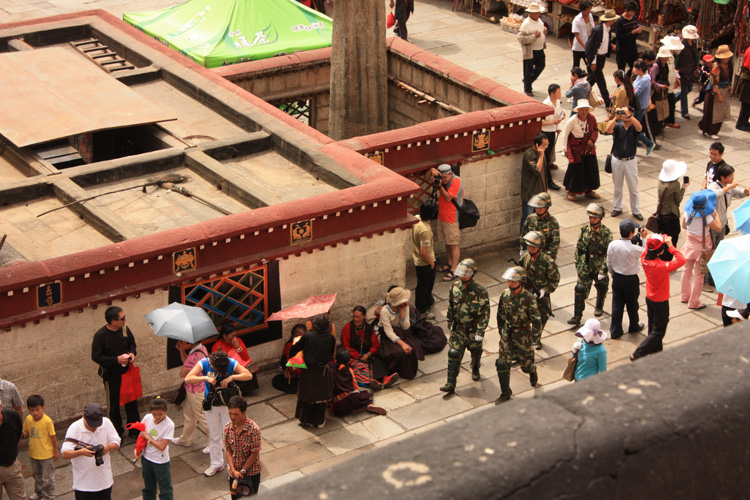The Keys to Lhasa
|
We are in a cramped train for fifty six hours. We have done our obligatory interviews, smiled appropriately and carefully avoided politics. From my sleeper car window, a movie reel of vertical granite walls bisects rolling hills in mind-numbing repetition. At 16,000 feet we are fast descending into Lhasa, the Holy City of two million people. I am exhausted, stiffly bracing to witness the urban sprawl and militarization.
Two enormous modern concrete bridges frame the tenth century Potala Palace at the foothills of the world’s tallest mountains. It is the city of Denver, only Chinese and communist. The train screeches to a halt at an eastern bloc train station where a dead general might be buried. We hurry past armed guards, metal detectors, begging Tibetans and taxi drivers. Each of us is handed a white scarf, a gift reserved for lamas, Tibetan priests. This last gesture infinitely depresses me. The Dalai Lama’s former residence is now a strip-mall palace. I am now a part of the tourism machinery.
Mandy our male Chinese tour guide with a woman’s name is nervous. He is on the tour bus microphone which is where we will come to know him best. It is his first time hosting a mixed east-west group. Tibet has been open to foreigners for only three months. He knows the government cancelled our permit once already.
His apprehension transforms him into a drill sergeant. “Tomorrow 6:30 a.m. wake-up call,” he barks. The westerners are in disbelief. Back on the bus the next morning we are scolded for being tardy. Our beginning and end time of one hour inside the Potala Palace will be recorded. Any deviation will be a poor reflection on him and by extension, ourselves.
Soldiers with machine guns perch on every |
|
|

street corner, music blaring. Flies swarm on swaying rib cages at butcher stalls while thick temple smoke clogs narrow lanes. Young Tibetan men in tight jeans, black wool vests and fedoras fondle amber prayer beads. They are going to pray, their angular cheek bones setting off wide dark eyes and red braids.
The Palace’s front entrance is pilgrims and spinning golden prayer wheels. On display are the Dalai Lama’s personal affects—his study, bedroom and eating bowls. The private chambers are crowded. Some whisper prayers to a leader who left them over fifty years ago. His replacement, a picture of the Panchen Lama, is the sanctioned substitute for a man whose photo will land you in jail. “If only Mao’s son had taken over. . . ” Liuke, a Chinese painter's voice trails off. "The Tibetans need to worship someone.”
Next it's Tibet’s holiest monastery, the Jokang. In an act repeated across all holy places we buy tickets and pay for photos with monks. Tour directors lead Chinese masses craning their necks to see jeweled statues in glass cases. How can anyone meditate here? Monks spend their days picking up cigarette butts and trash. They count currency left at the feet of idols, the logical endpoint of Chinese communism and spiritual enlightenment. Would the Buddha, like Jesus, turn over the temple money tables were he to witness such a scene? < next >
|